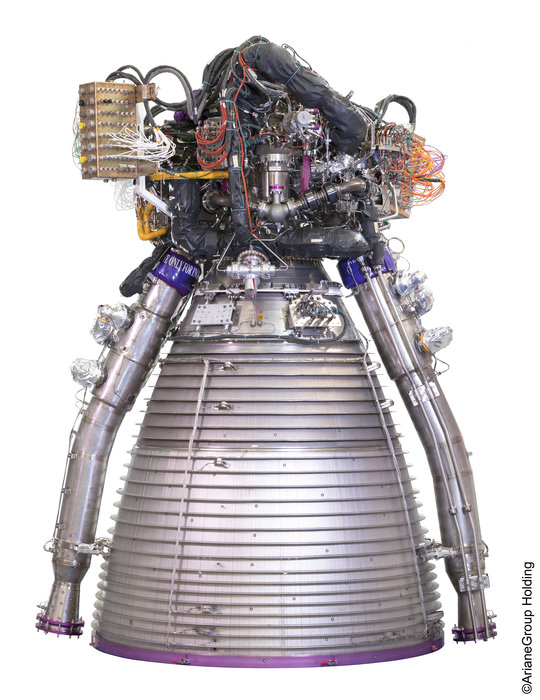Technical features

Ariane 62 and 64
Standing at a height of 62 metres, Ariane 6 will be taller than Ariane 5 (55 metres). There will be two variants, A62 and A64. With a mass of 530 tonnes, A62 will have two solid-rocket boosters and deliver 800 tonnes of thrust off the pad. With a mass of 860 tonnes, A64 will have four boosters and deliver 1,500 tonnes of thrust off the pad. The payload mass will depend on the launcher used and the orbit to be reached (low or medium Earth orbit, geostationary transfer orbit or Earth escape orbit for deep-space missions).Equipped Solid Rocket (ESR)
Most of the thrust lifting Ariane 6 off the pad will come from two solid-rocket boosters for A62 and four for A64. These P120C boosters derived from the first stage of the Vega launcher will be filled with 142 tonnes of solid propellant able to generate 350 tonnes of thrust at lift-off and burn for a total of 130 seconds. Unlike Ariane 5’s segmented metal P230 boosters, the P120C has a monobloc structure with a composite casing.
Lower Liquid Propulsion Module (LLPM)
The LLPM comprises the liquid-propellant tanks and the Vulcain 2.1 engine at its base. This stage will carry 150 tonnes of liquid hydrogen and oxygen fuel in all. As both these cryogenic propellants are very cold in their liquid state (–182°C for oxygen and –253°C for hydrogen), they pose a number of production issues and their tanks need to be protected with insulating materials.

Vulcain 2.1
The Vulcain 2.1 engine is 3.7 metres high, 2.5 metres wide and weighs 1,650 kilograms. Burning the propellants in the tanks above it, it delivers 135 tonnes of thrust at lift-off and helps to power Ariane 6 skyward for the first 10 minutes of flight up to an altitude of about 160 kilometres. Vulcain 2.1 is an enhanced version of the Vulcain 2 engine currently on Ariane 5. The main differences concern the nozzle, the additive manufacturing (AM) process for the gas generator and ignition from the ground rather than by pyrotechnic systems inside the engine.
Upper Liquid Propulsion Module (ULPM)
The ULPM upper stage is started above the atmosphere and imparts the extra velocity needed to inject the payload into orbit. It comprises the liquid oxygen and hydrogen tanks, which weigh 30 tonnes. At the base of this stage is the Vinci engine, more powerful than Ariane 5’s HM-7B (delivering 18 tonnes as opposed to 6.5 tonnes of thrust). Vinci will be reignitable, providing more flexibility in terms of possible orbit injection trajectories. The upper stage’s atmospheric re-entry will also be controlled by the reignitable Vinci or for certain trajectories by the APU (Auxiliary Power Unit), a low-thrust engine, thus limiting orbital debris that could otherwise create a potential collision hazard in operational satellite orbits.
Upper composite
Ariane 6 will feature a DLS (Dual Launch System) bearing structure, offering greater than volume than Ariane 5's SYLDA structure and capable of placing two payloads into orbit. A multiple-launch system dubbed Microsat Launch Share currently in the design phase will round out Ariane 6’s capabilities.
There will be two versions of Ariane 6’s fairing to protect payloads during ascent through the atmosphere: one 20 metres high—larger than Ariane 5’s (17 metres)—and a shorter one 14 metres high.
Technological innovations
Ariane 6 also features a number of technological innovations designed chiefly to reduce costs. Vulcain 2.1’s gas generator is produced by additive manufacturing (3D printing). The liquid-propellant tanks are welded by friction stir welding (FSW), which requires no addition of metal. With FSW, two abutting pieces are joined using a mobile weld tool that heats them until they become soft. Ariane 6’s cryogenic tanks are made from a mixture of aluminium and lithium—compared to the aluminium alloy used for Ariane 5—in order to lighten the launcher.


